In this comprehensive guide to keyword research for therapists, I’m going to show you an invaluable strategy for boosting your business’ visibility in search results and attracting new clients from Google.
How does it work?
Simple:
Using keyword research to discover the actual words and phrases (your SEO keywords) that your ideal clients type into search engines to find the mental health services and support they need.
More importantly, this process won’t just show you what those keywords are but will also make it easy to determine which ones are most likely to help you rank highly on the first page of Google and attract targeted visitors with a genuine interest in your services.
Below, I’ll walk you through the six simple steps to effective keyword research and recommend three top tools you can use to help you.
Before I do that, let me first explain a little bit about the different types of keywords and why they’re important.
SEO Keywords for Therapists: What Are They?
So, we’ve already established that keywords are the terms people enter into search engines like Google to find what they want.
That’s the gist of it, but if you’re going to do the most effective research, you need to know about the two main types of keywords, short-tail and long-tail.
1. Short-Tail Keywords
Short-tail keywords are generic terms, usually consisting of no more than three words.
“Counsellor,” is a good example of a short-tail keyword, as is “affordable therapist” or “online counselling.”
Compared to long-tail keywords, such terms generate much higher search volumes (the number of search queries made for that term each month), and therefore tend to drive the most traffic.
So, good news, right? Don’t you just have to find a bunch of relevant short-tail keywords, add them to your website and wait for the traffic to flood in?
Not necessarily.
You see, short-tail keywords do generate a ton of traffic, but because of this, they also generate a ton of competition from other therapists and mental health businesses, meaning you’ll really have to go above and beyond to rank highly in search results.
I’ll talk more about competing for keywords later (see Keyword Difficulty), but for now, let me tell you the other challenge with short-tail keywords:
They don’t always match the correct user intent for your services.,
For example, let’s say you do decide to target the SEO keyword “therapy.”
People who search for “therapy” may be looking for a wide range of services, including physical therapy, occupational therapy, speech therapy, or mental health therapy.
Without additional context, it’s challenging to determine what a searcher is looking for and to provide the most relevant information.
As such, even if you landed a coveted position in the top three search results for “therapy,” you’re not going to convert as many visitors into clients.
This is partly because you attract people who are looking for a different type of therapy than the one you provide and partly because using such a generic term usually indicates that people are still learning about therapy rather than approaching Google with the intent to hire a therapist.
To learn more about this, read my guide to SEO user intent.
FYI:
You’ll also see short-tail keywords referred to as “head terms.” I’ll be using both names interchangeably throughout this guide, so know that if you see either one, I’m talking about the same thing.
2. Long-Tail Keywords
Long-tail keywords are more narrowly-defined search terms that people use when they’re looking for a specific service or answer to a question.
As you’ve already worked out for yourself, they’re longer than short-tail keywords, usually containing three to five words.
Examples of long-tail keywords for therapists include:
- “What type of therapy do I need?”
- “Hypnotherapy for quitting smoking”
- “Affordable counselling in London SE1.”
Long-tail keywords don’t attract as many searches or website traffic as their short-tail counterparts, but their very specific nature makes them an ideal target for two reasons:
1. Less Competition
In 2022, Google noted that 15% of all searches on the platform have never been done before. That means every day, people are searching for the answers to new questions or trying to find certain new information.
This means that even other therapists who are targeting long-tail keywords are unlikely to target all the same ones that you do.
As you’ll see when we get into the step-by-step process of keyword research below, all of this results in there being fewer websites competing for a top position in search engine results pages (SERPs), increasing the likelihood that you can get your site ranked in a prime position for attracting visitors.
2. More Qualified Traffic
By ranking for long-tail keywords, you stand a better chance of driving what’s known as “qualified traffic” to your website.
In a nutshell, “qualified traffic” means that the visitors to your website are most likely to become clients, if not straight away, then at least somewhere down the line.
Think about it this way.
Let’s say a client is looking for a counsellor. So they head to Google and search for the head term “counsellor.”

That generates roughly 216 million results, not all of which are relevant to the user’s search intent of hiring a counsellor to help with their specific issue.
What’s more, since there’s so many other businesses and websites competing to rank highly for that generic search term, your business is nowhere to be found.
So, your user checks out a few of those results, don’t find what they’re looking for, and try again with a location-based long-tail keyword, “counsellor in Liverpool” to find a therapist close to their location.
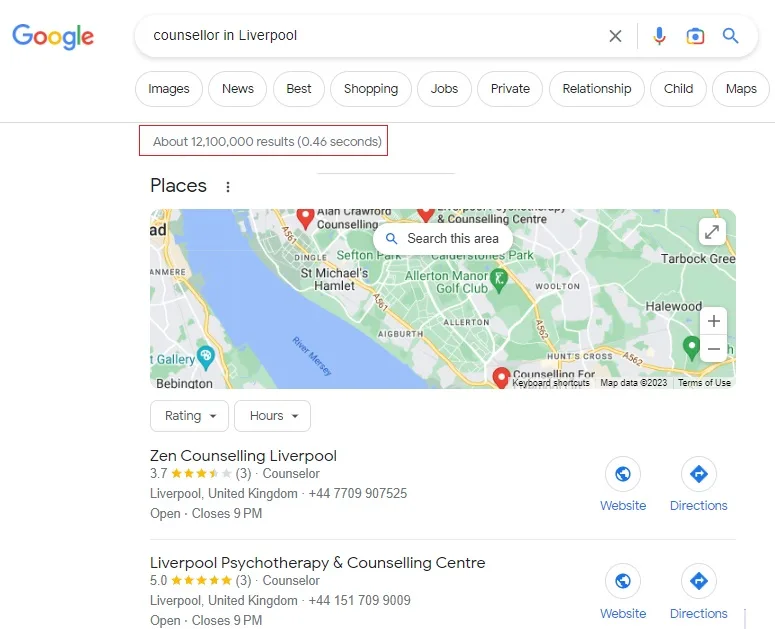
This narrows things down to a little over 12 million results.
It’s still a lot, but does come with the benefit of generating “Local Pack” results, which are the search results featuring local businesses that usually appear at the top of SERPs.
So, the user checks out a few more results and finds some good local therapists, but still none that provide the exact type of therapy they need. So, they try one more time with an even more specific long-tail keyword: “Trauma counsellor in Liverpool.”

This time, there’s only about 3 million search results, with all the most relevant ones at the top.
Because you used that phrase as the focus of your SEO content, your website is listed in the top ten search results for that term.
A user clicks through to your site, sees that you offer trauma counselling in Liverpool, gets in touch, and voila, a new client.
So far, so good, right? But how do you identify which short-tail and long-tail keywords your ideal clients are using on Google?
Let me show you:
Keyword Research for Therapists: Step-by-Step Process
1. Think Like Your Clients
First, grab a pen and paper, an app on your phone, or whatever you use to take notes.
Then, think about the services you offer and let your mind run wild with all the possible words and phrases your ideal clients would search for to find those services and the questions they might want answered before they hire a therapist.
There’s no right or wrong answers here.
All you’re doing is brainstorming a list of possible keyword ideas that you can later use to help you find which ones are worth targeting.
For example, if you’re a counsellor, you might come up counselling keywords such as:
- “Talk therapy in [your area]”
- “What is walk-and-talk therapy?”
- “Children’s counselling services in [your area]”
If you’re an art therapist, your brainstorming session might result in ideas such as:
- “Art therapy via Zoom”
- “Is art therapy right for me?”
- “Children’s art therapy.”
Quickly come up with as many as you can, but don’t tie your head in knots if your keyword ideas list is pretty small. This next step will help you expand it.
2. Use Search Engines to Find More Keywords
Now that you’ve got a few ideas of your own, it’s time to open a web browser to find the kind of answers and long-tail search terms your ideal clients are actually looking for online.
This step is even more important than the last one as it expands your ideas list with subjects that you can prove people are legitimately interested in learning about. Once you know what those subjects are, you can include them in your content marketing strategy to drive more qualified traffic to your website.
So, here’s what you need to do:
First, go to Google and type in head term that best describes your practice. “bereavement counsellor,” for example or, “art therapy.”

Notice how a whole bunch of suggested search terms appear related to the words you typed?
Those are all genuine search queries that people have previously entered into Google. In other words, there’s evidence that people are actively looking for things like “art therapy exercises for trauma” and “art therapy examples.”
If I were an art therapist, I’d definitely be adding those keywords to my list of ideas.
You can also find more ideas by searching for your head term and looking at the People Also Ask results.

These are among the most searched-for genuine questions that people have asked Google, making them a prime target for your blog content, FAQs, or service pages.
Finally, you can look at the bottom of the search results for the Related Searches.
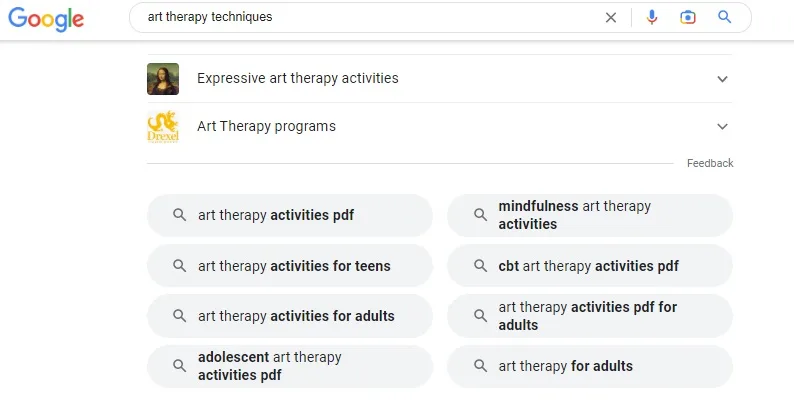
Again, these are real search queries that people have entered into Google, showing you exactly the kind of content your audience wants.
3. Pick a Keyword Research Tool
By now, you’ve hopefully got a good, solid list of potential keywords.
Technically, you could go ahead and start adding all those keywords to your website and hoping for the best, but let’s face it:
That would take ages, and there’s no guarantee that the keywords you use are best suited for getting your website ranked highly in search results.
This is why the next phase of keyword research for therapists is to analyze those keywords, looking at some crucial details of each one so that you can make an informed, data-driven decision about which ones are the most valuable to your private practice.
To do that, there are any number of free keyword research tools you can use.
A lot of people really like Google Keyword Planner, a free platform that was designed to help people create targeted paid ads but works just as well for SEO.
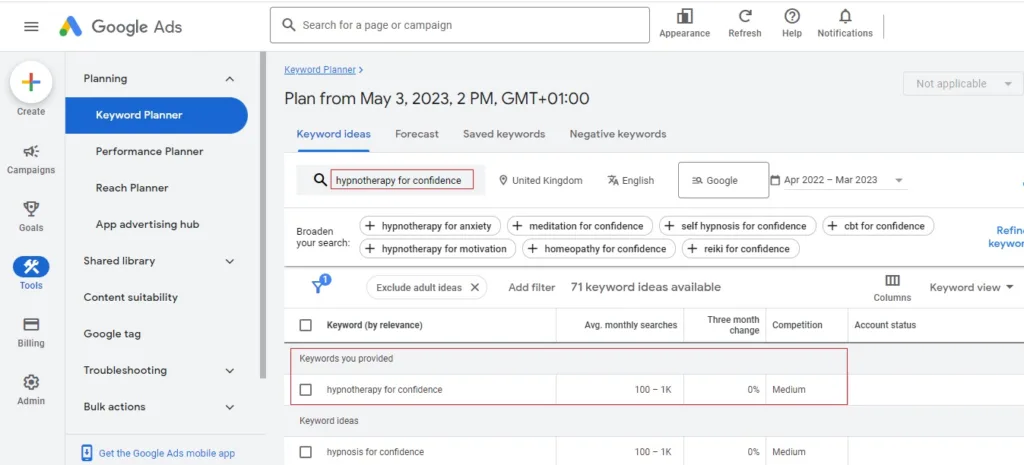
The way it works is pretty simple:
Type in the keyword you want to rank for, and Keyword Planner will show most of the valuable data you need to make decisions about which keywords to use.
I’ll talk more about that data in a second, but first, let me tell you about one of my favorite keyword research tools, SemRush.
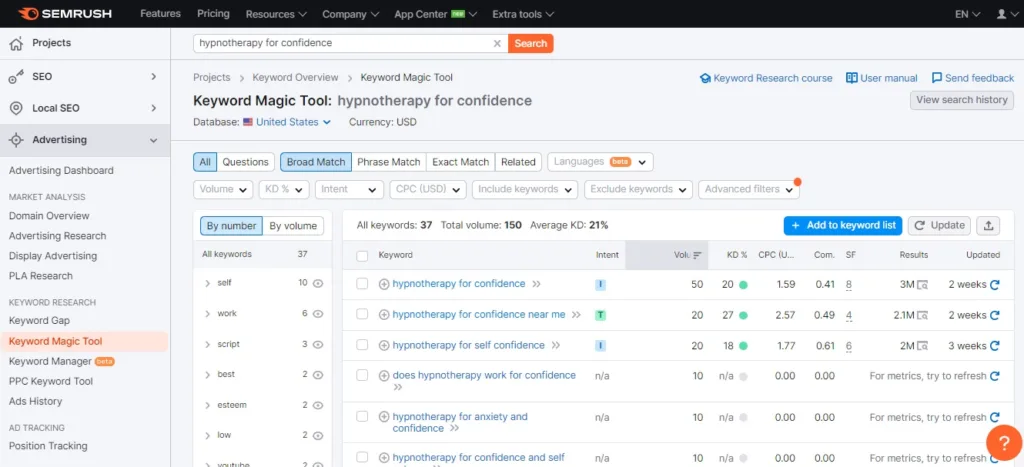
I love SemRush because it’s super easy to use, provides a wealth of highly accurate data, and its Keyword Magic Tool is free to use.
I’ll be using this platform for the rest of this tutorial, but feel free to work with Keyword Planner or another top tool like Ahrefs Keyword Generator, as the process is essentially the same no matter which tool you use.
4. Analyze and Evaluate Your Keywords
Whichever keyword research software you use, enter the search term you want to rank for and look at the three following pieces of information for each one:
A. User Intent
As I discussed earlier, the term “user intent” (often referred to as “Search intent”) refers to the goal that users have when they enter a specific query into a search engine.
I should point out here that of the three tools listed above, only Semrush offers search intent data.
When it comes to SEO, there are four main types of search intent:
Informational:
A search user wants to learn more about a subject. At this stage, they don’t have any specific intent to hire your services; they’re just looking for information.
Keywords with informational intent are great for incorporating into your blog posts and articles to establish your expertise and earn a level of trust from your readers.
Navigational:
Navigational intent is when people are looking for a particular website or brand, such as YourPractice.com or Therapist Marketing Tips.
Although Navigational Intent won’t form a huge part of your content strategy, it’s still important to ensure that your name and the name of your business are prominent on your website.
You never know when someone may see your marketing materials, recall your name but not your website, and head to Google to find you.
Commercial:
People who search with commercial intent know that they want to buy a product or hire a service, but haven’t yet decided which one.
They’re doing what’s known as “commercial investigating,” researching the different options to find the one best suited to their needs or budget.
A great example with commercial intent would be “what type of therapy is best for me?”
Transactional:
Transactional intent means that people are ready to make a purchase. They’ve done their commercial investigating and now know exactly what they want.
Understanding the user intent of your target keywords will help you to better understand what it is your clients want and the best way to give it to them.
B. Search Volume
Search volume refers to the number of times a keyword is searched for every month.
High-volume keywords tend to be short-tail keywords that loads of people search for, meaning they drive a tonne of traffic to websites that rank in the top 1 – 10 search results for that keyword.
Low-volume keywords are usually long-tail. Although they don’t drive the same quantity of traffic, the quality of that traffic is often superior thanks to the super-specific nature of the search term.
B. Competition / Ranking Difficulty
Keyword Difficulty (KD) tells you how hard it is to rank in the top 10 organic search results for a keyword. This is usually expressed as a score out of 100.
The higher the KD score, the harder it’s going to be to get a good SERP position.

For example, the keyword difficulty of the search term “how does art therapy help” is around 56-57, which is fairly high but still within your grasp if you’re good at creating content.
5. Use the Data to Prioritize Your Most Valuable Keywords
So, you’ve typed a keyword into your preferred tool, and you’ve got a whole bunch of data about search volume and keyword difficulty.
Now, you’re going to use that data to determine which keywords to target.
Start by looking for keywords that have a high search volume and low KD score.
Although rare, these are the best keywords for mental health content as they’re easy to rank for but still likely to drive a lot of traffic to your site.

“Counselling for depression” might be a good one to target as it has a relatively high search volume compared to other therapy-related terms but has a low KD score of just 22, meaning it should be easy to rank for if you create high-quality content focused on that keyword.
Next, look at Low Volume/Low KD keywords as it should still be fairly easy to get a strong position in search results for these keywords. Sure, they won’t drive as much traffic, but people are still entering these search terms into Google, so you’re still going to get some traffic.
Besides, these low-volume keywords will also have other benefits for your site, as they can actually help you rank for higher KD terms down the line. That, however, is another blog post for another time.
Finally, High/Volume/High KD keywords are a bit of a gamble. If you’re absolutely confident that you can create better content than what’s listed in the top 10 search results for that keyword, then go for it. The rewards will be huge as you’ll probably attract a tonne of traffic.
However, if you do all that work and still don’t rank in the top 10, you’ve essentially wasted a whole bunch of time that would’ve been better spent targeting lower KD keywords.
6. Incorporate Keywords into Your Private Practice Website
By using the steps above, you’ve determined which keywords are going to be most useful for driving potential clients to your website.
Your next task is to start adding them to your content in a way that is relevant, natural, and matches the user intent.
Use your long-tail informational intent keywords in blog posts and articles to establish your expertise and drive qualified traffic.
Add your commercial intent keywords to service pages, and be sure to add a compelling call to action, as these are the pages most likely to land you new clients.
When you’re done, use the likes of Google Analytics or Semrush to track the kind of rankings and search traffic they generate as this will help you determine which types of keywords and subjects get the best results for your practice.
Keyword Research for Therapists: Key Takeaways
Whether you’re trying to determine the right SEO keywords for mental health services you offer or building relationships with potential clients through targeted quality blog content, this guide to keyword research therapists covers everything you need to know to get started.
To recap:
- Focus on long-tail keywords – Not only are they usually easier to rank for, but they can also help drive more qualified traffic to your website.
- Generate a keyword ideas list – Consider all the possible search terms people might use to find the kind of content and services you offer.
- Use keyword research tools to find the most useful keywords – Aim for High Volume/Low KD keywords where possible, followed by Low Volume/Low KD terms. Only go after High Volume/High KD keywords if you’re confident you can outrank the competition.
- Add and track your keywords – Ensure the content matches the user intent and that keywords are used in a natural and relevant way
Enjoyed this post? Get more marketing advice for therapists every week by following Therapist Marketing Tips on Facebook.


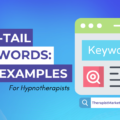
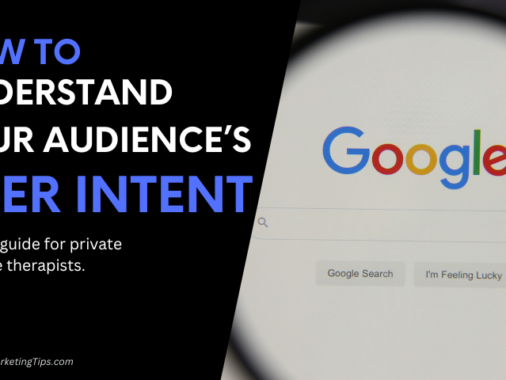

Comments are closed.